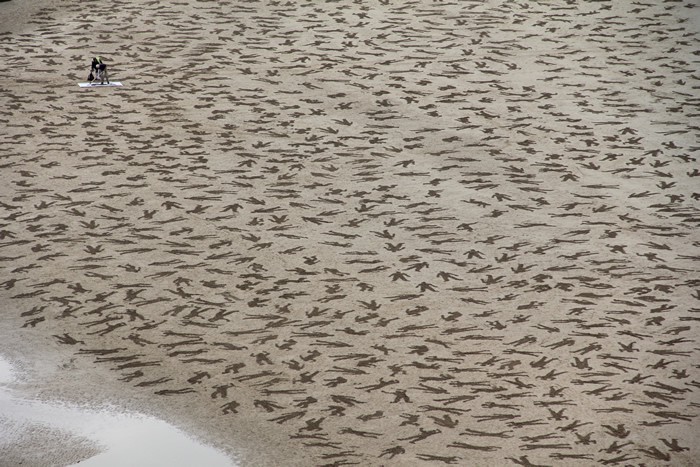The Fallen 9000: Sand Art Immortalizes the Heroes of D-Day
On the shores of Normandy, a poignant art installation stands as a testament to the sacrifice of thousands who gave their lives on D-Day. Conceived by British artists Jamie Wardley and Andy Moss, “The Fallen 9000” is a moving portrayal of the 9,000 individuals who perished during the historic D-Day beach landings at Arromanches on June 6th, 1944, amid the tumult of World War II.

In 2013, Wardley, Moss, and an initial team of 60 volunteers took to the beaches armed with rakes and stencils. Together, they meticulously etched 9,000 silhouettes into the sand, each representing a fallen soldier, both Allied and German. What began as a small group effort expanded exponentially as nearly 500 local residents joined in, creating a temporary installation that lasted only a few hours before being washed away by the tide.
D-Day, the largest seaborne invasion in history, unfolded on June 6, 1944, marking a pivotal moment in World War II. Allied forces, comprising American, British, Canadian, and other troops, stormed the heavily defended coast of Normandy, France. The operation involved five beaches—Juno, Utah, Gold, Sword, and the infamous Omaha.
The Allies, aware of German expectations, chose Normandy over Calais for the invasion, leading to a surprise assault. Despite meticulous planning and an extensive military deception named Operation Bodyguard, D-Day faced challenges, including adverse weather conditions. The operation, codenamed Neptune, commenced the liberation of France and Western Europe, setting the stage for the Allied victory on the Western Front.
The Normandy landings began with an airborne assault, followed by amphibious landings on the coast. However, things did not go as smoothly as planned. Strong winds and fierce German resistance led to challenges, especially at Omaha Beach, where 2,400 soldiers lost their lives. Despite initial setbacks, the Allies gradually expanded their foothold over the following months.
The sacrifice on D-Day was immense, with German casualties estimated between 4,000 and 9,000 and Allied casualties documented at least 10,000, including 4,414 confirmed dead. Key objectives like Carentan, Saint-Lô, and Bayeux remained in German hands initially, emphasizing the resilience required in the face of formidable opposition.
“The Fallen 9000” serves as a poignant reminder of this sacrifice. By etching silhouettes into the sand, Wardley and Moss, alongside dedicated volunteers, transformed a stretch of beach into a temporary memorial. The impermanence of the installation mirrors the fleeting nature of life, emphasizing the brevity of those 9,000 lives lost on that fateful day in 1944.
As we remember D-Day and honor those who fought and fell, installations like “The Fallen 9000” become powerful symbols, ensuring that the legacy of sacrifice endures through art, memory, and the pages of history.
